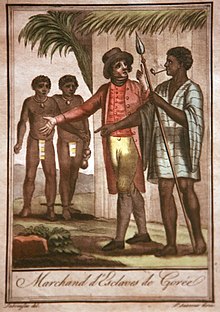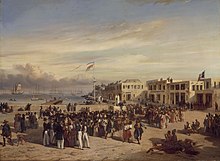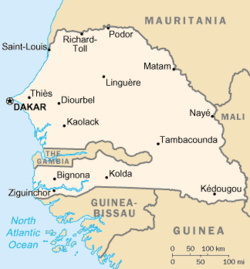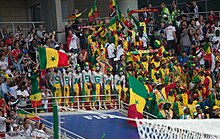Senegal
Senegal, whose official name is Republic of Senegal (French: République du Sénégal), is a sovereign West African state whose form of government is the semi-presidential republic. Its territory is organized into fourteen regions.
It owes its name to the Senegal River, which marks the eastern and northern border of the country. Senegal borders the Atlantic Ocean to the west, Mauritania to the north, Mali to the east, and Guinea and Guinea-Bissau to the south. The Gambia forms a virtual enclave within Senegal, following the Gambia River for more than 300 km inland. The Cape Verde Islands lie 560 km offshore, off the Senegalese coast. The country's population is estimated at approximately 16 million people. The climate is tropical with two seasons, one dry and the other rainy.
Dakar, the capital of Senegal, is located at the westernmost point of the country, on the Cape Verde peninsula. During the 17th and 18th centuries" , numerous trading posts belonging to different colonial powers were established on the coast. The city of St. Louis became the capital of French West Africa at that time before it moved to Dakar in 1902. Dakar later became its capital in 1960 at the time of independence from France.
Toponymy
The country gets its name from the Senegal River, whose etymology is disputed. A popular theory, proposed by David Boilat in 1853, states that it derives from the Wolof expression sunu gaal, meaning "our canoe", resulting from the difficulty of communication among Portuguese sailors. 15th century and Wolof fishermen. Modern historians believe that the name probably refers to the Zenaga Berber ethnic group, who lived on the north bank of the river. A competing theory claims that the name derives from the medieval town of "Sanghana" (also known as Isenghan, Asengan or Singhanah), described by the Arab geographer al-Bakri in 1068 as located at the mouth of the river. Despite all of the above, the "our canoe" it has been popularly embraced in modern Senegal for its warmth and usefulness in calls for national solidarity (for example, "we are all in the same canoe") makes it frequently heard in the media.
Some southern Serer believe that the river's name originally derives from the union of the Serer terms "Sene" (from Roge Sene, supreme deity of the Serer religion) and "O Gal" (meaning "body of water").
History

Archaeological finds throughout the area indicate that Senegal was inhabited in prehistoric times. Islam was established in the Senegal River Valley in the 16th century; 95% of Senegalese today are Muslim. In XII through XIV , the area came under the influence of the Mandingo empires from the East; the Jolof Empire of Senegal was also founded during this time. In the 16th century, the Jolof Empire split into four competing kingdoms: the Jolof, Waalo, Cayor, and Baol.
Various European powers (Portugal, the Netherlands, and England) competed for trade in that area from the 15th century, until in 1677, France ended possession of what had become an important starting point for the slave trade (the island of Gorée, near Dakar). Only from the 1850s did the French, under Governor Louis Faidherbe, begin to expand into Senegalese territory itself.
In January 1959, Senegal and French Sudan joined to form the Federation of Mali, which became a fully independent nation on June 20, 1960, as a result of the independence and transfer of power agreement signed with France on April 4, 1960. Due to internal political difficulties, the Federation dissolved on August 20, 1960. Senegal and Sudan (renamed the Republic of Mali) proclaimed their independence. Léopold Senghor, a well-known international blackness poet, politician, and statesman, was elected Senegal's first president in August 1960.
After the dissolution of the Federation of Mali, President Senghor and Prime Minister Mamadou Dia ruled together under a parliamentary system. In December 1962, their political rivalry led to an attempted coup by the Prime Minister. The coup was brought down without bloodshed, and Dia was arrested and jailed. Senegal adopted a new constitution that consolidated the power of the President. In 1980, President Senghor retired from politics and transferred the post to his handpicked successor, Abdou Diouf, in 1981.
Senegal joined with The Gambia to form the Senegambian Confederation on February 1, 1982. However, the envisioned integration of the two countries never took place, and the union was dissolved in 1989. Despite talks of paz, a separatist group from the south, in the Casamanza region, has clashed sporadically with government forces since 1982. Senegal has a long history of involvement in international peacekeeping.
Abdou Diouf served as president from 1981 to 2000. He encouraged more than broad political participation, reduced government intervention in the economy, and expanded Senegal's diplomatic engagement, particularly with other developing nations. Domestic politics sometimes spilled over into mob violence, border tensions, and a violent separatist movement in the southern Casamanza region. However, Senegal's commitment to democracy and human rights has been consolidated over time. Diouf served four terms as President. In the 2000 presidential election, he was defeated in democratic elections by opposition leader Abdoulaye Wade. Senegal experienced its second peaceful transition to power, and its first from one political party to another.
On December 30, 2004, President Abdoulaye Wade announced that he would sign a peace treaty with two breakaway factions of the Movement of Democratic Forces of Casamanza (MFDC) in the Casamanza region.
Government and politics
Senegal is a presidential republic. Its president has been elected every five years since 2001, the year in which Mame Madior Boye was the first woman to become Prime Minister of Senegal, previously being elected every seven, by adult vote. The current president is Macky Sall, elected in March 2012.
Senegal has more than 80 political parties. The bicameral Parliament consists of the National Assembly, which has 120 seats, and the Senate, which has 100 seats and was reinstated in 2007. In Senegal, there is also an independent judicial system. The highest levels of national justice are the Constitutional Council and the Court of Justice, their members being appointed by the president.
Senegal functions democratically, being recognized as one of the countries with the most successful and deep-rooted democratic culture in Africa. [citation needed] Local administrators are appointed by the president and are accountable to him. The marabouts, religious leaders of the different Muslim brotherhoods in Senegal, also have a certain political influence in the country, especially during Wade's presidency. In 2009, however, Freedom House downgraded Senegal's political status from "free" to "partly free" as a consequence of the increased concentration of power in the executive.
In 2008, Senegal finished 12th in the Ibrahim Index of African Governance. The Ibrahim Index is a comprehensive indicator of governance in Africa, based on on a number of different variables that reflect the success with which each government provides basic political goods to its citizens. In 2010, Senegal was ranked 15th in the index.
In 2012, Senegal hosted a controversial presidential election as a result of the dubious candidacy of President Abdoulaye Wade. Finally, Macky Sall was victorious in the elections, and Wade accepted his defeat. This peaceful and democratic result was hailed by many international observers, such as the EU, as a sign of "maturity". In 2013, Aminata Touré was Prime Minister of Senegal until 2014.
Human Rights
In terms of human rights, regarding membership of the seven bodies of the International Bill of Human Rights, which include the Human Rights Committee (HRC), Senegal has signed or ratified:
Political-administrative organization
Senegal is subdivided into 14 regions, each administered by a Conseil Régional (Regional Council) elected according to the weight of the population at the level of each Arrondissement. The country is further subdivided into 45 Départements, 103 Arrondissements (none of which have administrative functions) and Collectivités Locales, each which elects administrative officers.
Regional capitals have the same name as their regions:
- Dakar
- Diourbel
- Fatick
- Kaffrine
- Kédougou
- Kolda
- Louga
- Matam
- Saint-Louis
- Tambacounda
- Kaolack
- Sédhiou
- Thiès
- Ziguinchor
Geography and climate
Senegal is located in the western part of the African continent, between 12º8' and 16º41' north latitude, and 11º21' and 17º32' west longitude. Its western point, Cape Verde (and particularly the site of Dakar's Club Med), constitutes the westernmost part of the African continent.
The Senegalese landscape consists mainly of undulating sand flats in the western Sahel that grow to the foothills in the southeast. There is also the highest point in Senegal, an unnamed landform near Nepen Diakha, 581 m high. The northern limit is formed by the Senegal River. Other notable rivers are the Gambia River and the Casamanza River. The capital Dakar lies on the Cape Verde peninsula, the westernmost point of mainland Africa.
The country stretches over 196,722 km². Compared to its neighboring countries (Mali and Mauritania), Senegal is a tiny country.
The climate is Sahelian with:
- A rainy season from June to October, with inflection in August, and variable according to latitude (less rainy in the north than the south). Temperatures reach their peak. It is the period of monsoons, which causes tropical and hurricane storms in the Caribbean area.[chuckles]required]
- A dry season from November to June, with continental alisios. In this station, specifically in January, the minimum temperatures are reached.
On the coast, the sea softens the temperatures, which are in the order of 16 °C to 30 °C; but in central and eastern Senegal, they can reach 41°C.
During the European winter, Senegal becomes a popular destination for tourist activities.
Ecology
According to WWF, the territory of Senegal is divided into four ecoregions:
- Taste of Sahel acacias in the north.
- Western Sudanese savanna, central and southeast.
- Mosaic of jungle and savannah of Guinea, west and south.
- Mangrove Guinean, at some points of the southern coast.
Parks and nature reserves
Nature parks and reserves represent 8% of the national territory. They have an important role in preserving the environment and contribute significantly to tourism development. A total of 169 species of mammals and 540 species of birds have been identified in these protected areas.
Senegal has six national parks: Niokolo-Koba National Park, in the east of the country; the Djoudj National Bird Park; the Barbary tongue national park, in the Saint-Louis region; the national park of the Isles de la Magdalena along Dakar; the national park of the Delta del Salum in the south, and the national park of Lower Casamance, closed for a few years due to unrest in the region.
The country also includes about thirty smaller nature reserves, such as the Guembeul Reserve, the Bandia Reserve, the Popenguine Nature Reserve, or the Bamboung marine protected area.
Economy
After its economy contracted by 2.1% in 1993, Senegal launched a major program of economic reforms with the support of the international donor community. This reform package began with a 50% devaluation of the country's currency, the CFA Franc. Price controls and government subsidies were also dismantled. As a result of the above, Senegalese inflation was contained and decreased, investment increased, and GDP grew by around 5% per year between 1995 and 2001.
The main economic sectors in Senegal are food processing, mining, cement, artificial fertilizers, the chemical industry, refining of imported petroleum products, and tourism. The country's main exports are fish, chemicals, cotton, cloth, peanuts, and calcium phosphate, and the main foreign markets are France, the United States, China, Italy, India, and the United Kingdom.
As a member of the West African Economic and Monetary Union (UEMOA), Senegal is taking steps towards greater regional integration and unified external tariffs. Senegal is also part of the Organization for the Harmonization of Business Law in Africa.
Tourism
With the introduction of the first Club Med resort in the 1970s, the growth of tourism began, which today is an important part of the country's economy. Since the 1990s, Senegal has made an effort to attract tourists from France, as Senegal was previously one of its domains. It is also attracting tourists from Spain, the United Kingdom and Italy, partly motivated by the example of its neighbor The Gambia, which has a higher percentage of tourists from Northern Europe and the Americas thanks to the coastal resorts of Banjul.
In 2008, Senegal reached one million foreign tourists. His rate of return stayed at approximately 30% (2008).
Demographics
Senegal has a population of about 16.9 million, about 42% of whom live in rural areas. The density in these zones varies from a high density of inhabitants per square kilometer in the central-western region to less than 10 per square kilometer in the arid eastern section.
Ethnography
Senegal has a wide variety of ethnic groups and, like most West African countries, several languages are spoken. The Wolof are the largest ethnic group in Senegal, at 43%; The Fula and Toucouleur (also known as Halpulaar'en, literally «speakers of Pulaar») (24%) are the second largest group, followed by the Serer (14.7%), and then others such as the Jola (4%), the Mandinka (3%), the Moors or (Naarkajors), the Soninké, the Basari, and many smaller communities (9%).[citation required]
Some 50,000 Europeans (mostly French) reside in Senegal. A smaller number of other emigrants, specifically Lebanese Mauritanians and Moroccans, reside in Senegal, mainly in the cities and some retirees residing in the tourist towns around Mbour. The majority of Lebanese work in commerce. main street is called «avenue du Senegal».
The country experienced a wave of immigration from France in the decades between World War II and Senegalese independence; most of these French people acquired homes in Dakar or other large urban centers. There are also small Vietnamese communities and a growing number of Chinese immigrants, each numbering a few hundred people. There are also tens of thousands of Mauritanian refugees. in Senegal, mainly in the north of the country.
According to the Global Refugee Survey 2008, published by the US Committee for Refugees and Immigrants, Senegal had a refugee and asylum-seeking population of approximately 23,800 in 2007. The majority of this population (20,200) comes from Mauritania. The refugees live in N'dioum, Dodel and small settlements along the Senegal River valley.
Languages
French is the official language, spoken at least by everyone who spent several years in the educational system of French origin (the Koranic schools are even more popular, but Arabic is spoken less outside the context of recitation). However, overall, French is only understood by around 15-20% of males and 1-2% of females. During the century XV, many European territories began to trade with Senegal. In the 19th century, France increased its colonial influence in Senegal, so the number of Francophones multiplied continuously. French was ratified as the official language of Senegal in 1960, when the country achieved independence.
Most of the population also speak their own ethnic language, while, especially in Dakar, Wolof is the lingua franca. The fula is spoken by the fulas and the toucouleurs. In total, Senegal is home to some 39 different languages. Several have the legal status of «national languages»: Balanta-ganja, Arabic, Jola-fonyi, Mandenká, Mandjak, Mankanya, Noon (Serer-Noon), Pulaar, Serer, Soninke and Wolof.
English is taught as a foreign language in secondary education and in many postgraduate programmes, and is the only subject to have a special office in the Ministry of Education. Dakar is home to a couple of bilingual schools offering 50 % of their curriculum in English. The Senegalese American Bilingual School (SABS), Yavuz Selim, and the West African College of the Atlantic (WACA) train thousands of English-dominant individuals in four-year programs. English is widely used in the scientific and business community, including by modou-modou (self-taught, illiterate businessmen).
Religion
Senegal is a secular state, although Islam is the predominant religion in the country, practiced by 96.6% of the population; The Christian community, with 3.3% of the population, is mostly Catholic, but there are also various Protestant denominations. Less than 1% have animist beliefs, especially in the southeast region of the country.
According to a 2012 Pew demographic study, 55% of Muslims in Senegal are Sunnis of the Sufi-influenced Maliki madhhab, while 27% are non-denominational Muslims. Senegalese are usually organized around one of several Islamic Sufi orders called tariqas, headed by a khalif, who is usually a direct descendant of the group's founder; according to the study, 92% of Senegalese Muslims belonged to a Sufi order. The two largest and most prominent Sufi tariqas in Senegal are the Tijaniyyah, whose largest Senegalese subgroups are based in the cities of Tivaouane and Kaolack and have a wide following in West Africa outside of Senegal, and the Murīdiyya, which is based in the city of Touba and has a fan base limited mainly to the interior of Senegal.
Main cities
Senegal's capital is Dakar, by far the largest city in the country with more than two million residents. The second most populous city is Touba, a communauté rurale (rural commune) de jure, with more than half a million.
Culture
Senegal is known throughout Africa for its musical influence and heritage, thanks to the popularity of the mbalax, which originates from the Serer percussion tradition. This music was popularized by Youssou N'Dour, among others, achieving great international success. Sabar percussion is especially popular. The sabar is mainly used in special celebrations, such as weddings. Another instrument is the tama. Other internationally renowned popular musicians include Ismael Lô, Cheikh Lô, Orchestra Baobab, Baaba Maal, Akon, Thione Seck, Viviane, and Pape Diouf.
Senegal is known for the West African tradition of storytelling, carried out by the griots, who have kept the history of the region alive for thousands of years through their words and music The profession of griot is passed from generation to generation, and requires years of training and apprenticeship in genealogy, history and music. The griots give a voice to generations and generations of African society.
Festivities
| Date | Name in Spanish | Local name | Notes |
|---|---|---|---|
| 1 January | New Year | Nouvel An | |
| 2 January | New Year | The am Hejir Eid-ul-Adha | Muslim; it can change day |
| 29 January | Ashura | Muharrum/Dr. Babu Jagjivan Ram | Muslim; sometimes 2 days |
| 2 February | Great Magal of Touba | Muridist; only in Touba | |
| 31 March | Birthdays of the Prophet | Eid-Milad Nnabi | Muslim; it can change day |
| 4 April | Independence Day | Anniversaire de l'indépendance | National Party |
| 9 April | Easter Monday | Lundi de Pâques | Catholic and Protestant |
| 1 May | Feast of Work | Fête du Travail | |
| 28 May | Monday of Pentecost | Catholic and Protestant | |
| 15 August | Assumption of Mary | Assomption de Marie | Catholic |
| 13 October | End of Ramadan | Muslim; it can change day | |
| 1 November | Day of All Saints | Toussaint | Catholic |
| 16 December | Feast of the Lamb | Eid-ul-Adha / Tabaski | Muslim; it can change day |
| 25 December | Christmas | Noël | Catholic and Protestant |
Sports
Senegalese wrestling is the country's national sport. Traditionally it was practiced as a distraction and to defend the pride of the village, but for a few years now the broadcast of the fights on television and the appearance of private sponsors have professionalized the sport (formerly the victorious wrestlers of the fights received pieces of cattle and now evenings are held in which large amounts of money are distributed) and the wrestlers are very popular characters throughout the country. The fame that the sport has acquired in recent years has transcended borders, and the no-hit variant has spread to other countries, especially France, where the largest Senegalese community resides abroad.
Contenido relacionado
Newfoundland and labrador
North America
Anoeta












